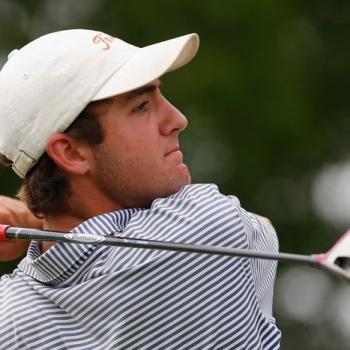Dustin Johnson leads the British Open after the incompleted second round of play on day 2, Friday. He and Jordan Spieth were paired together the first two rounds. Spieth is 5 under par, tied for 15th place. A rain delay earlier in the day caused play to have to suspended at darkness today. Johnson and Spieth were on the 13th hole. So, they will have to go out early tomorrow morning to finish their second round. It was the feature pairing since Spieth had won the U.S. Open weeks ago by one stroke when Dustin Johnson three-putted the last hole from close range to lose by one stroke.
They are playing the tournament at the home of golf–the Old Course at St. Andrews. I played it one time as a liesure round of golf. When I finished the round I said, “This is a game I do not know.” There is nothing like that golf course in the U.S., although they say Chambers Bay near Tacoma, Washington, opened in 2007 and where the U.S. Open was held weeks ago–has some similarities.
St. Andrews has unusual, deep greenside pit bunkers with steep sod walls that can make it very difficult to ecstract the ball in one shot. Sometimes, just to get out of the bunker you have to play backwards away from the hole. Then there also little pit bunkers that dot the middle of some fairways, where even a good drive off the tee can wind up. The course also has grass-covered valleys and mounds, with some greens having much undulation. Oftentimes the best play around the greens is a putter rather than a wedge. That’s why they say “links golf,” which is what this is called, is played more “on the ground” than “in the air,” as in the U.S. Then at St. Andrews there is the heather off the fairways. That is narly.
But St. Andrews is known mostly for having seven large greens that accommodate two pins each. Thus, this eighteen-hole golf course only has eleven greens. You might think it’s because of that Scottish penchant for being miserly, thus spending little money. But that’s not it. St. Andrews is the first golf course ever built, and for a very long time it was played both forwards and backwards. Furthermore, for a long time it did not have eighteen holes; rather, it had twenty-two holes. They say it eventually was changed to eighteen holes because it takes a foursome eighteen holes to finish off a pint of Scotch when each members of the foursome has a nip before beginning each hole. But that may be a big yarn.
Yes, they used to play golf forwards and backwards. That’s why the layout at the Old Course goes straight out for nine holes and then comes in the back nine. But the way they used to play was to go straight out for eleven holes, turn around, and play right back where they had just played. I learned about this when I was a in highschool reading history books about golf, especially golf course architecture. In the ensuing years, I began to think that that was a good idea and that it should not have been abandoned. So, I eventually bought property in Yakima, Washington, and started to build such a course there in 1981. But I had some problems, some of which didn’t have anything to do with the project itself, and I had to abandon the idea.
But that summer I told my dear friend, former college roommate and PGA Tour pro, Joel Goldstrand, about it. At the time, he was both a club pro in Minneapolis and a golf course designer. He thought it was a great idea and asked if I would mind if he tried. I said yes, and during the next several years Joel built seven nine-hole “reversible golf courses,” which were the first ever built in the U.S. and in the world during modern times. Most of them are in Minnesota. You play them in one direction one day and in the opposite direction the next day. It also works well having an odd number of seven days in a week. To make such a course, you have to have ten greens and eighteen tees. Eighteen hole shot-gun tournaments can be held, in which the groups tee off simultaneously, play the full nine holes, and then each group turns around and plays the same course they just played except they play backwards.
An interesting thing about St. Andrews is that when it was first built, it had only three holes that went straight out in the same direction. So, it could only accommodate one group at a time. When that group finished those three holes, those players turned around and played back over the same layout but in the opposite direction. They eventually added more holes until they had eleven, and that was the total number of holes at St. Andrews for a long time.
Tiger Woods said in an TV interview he would like to play a practice round at St. Andrews forwards and backwards, the way it used to be played. He said in the early years when he played St. Andrews, he would wonder why some of those little pit bunkers in fairways were so out of play. Then when he learned that the course used to be played forwards and backwards, he began to realize why some of them were so positioned. However, there is another reason for the location of some of those bunkers in modern days–when the wind blows really hard, for which that blimy Scotland is known, some of those bunkers, although only 200 yards or less off the tee, can come into play on the teeshot even for the pros. They say the wind could howl there this weekend. Watch those little pesky pit bunkers. They say those bunkers are that way because they used to be where the shepherder gathered his sheep to stay out of the cold, blustery winds of that old country.














